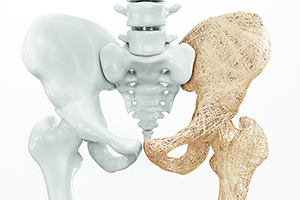In a recent article, entitled “A Perfect Storm for Broken Bones”, New York Times health writer Jane Brody decries “a crisis in the treatment of osteoporosis”. Not enough women are being screened, and too few are taking bone-preserving drugs, she alleges:
“A ‘perfect storm’ threatens to derail the progress that has been made in protecting the bone health of Americans. As the population over 50 swells, fewer adults at risk of advanced bone loss and fractures are undergoing tests for bone density, resulting in a decline in the diagnosis and treatment of osteoporosis, even for people who have already broken bones.
If this trend is not reversed, and soon, by better educating people with osteoporosis and their doctors, the result could be devastating, spawning an epidemic of broken bones, medical office visits, hospital and nursing home admissions and even premature deaths.
Currently, many people at risk of a fracture — and often their doctors — are failing to properly weigh the benefits of treating fragile bones against the very rare but widely publicized hazards of bone-preserving drugs, experts say.”
Reading this article disappointed me deeply. I am concerned that both the author and the Times are uncritically parroting the results of studies done for the explicit purpose of selling more drugs.
Curious, I skimmed the hundreds of reader comments prompted by the Brody article. They were overwhelmingly skeptical. Here’s a sample:
“It’s really not worth reading Jane Brody’s columns since one can find the same point of view in the barrage of Big Pharma marketing to which we are subjected.”
“I was disturbed by Jane Brody’s article—and felt she was simply writing for the drug companies, not sharing a true overall picture.”
Many readers decried Brody’s emphasis on pharmacological fixes, citing the documented benefits of diet and lifestyle. Others provided references to articles that challenge the safety and effectiveness of drugs for osteoporosis.
One such article, “Rethinking the Appraisal and Approval of Drugs for Fracture Prevention”, appeared recently in the journal Frontiers in Pharmacology. The authors conclude:
“After decades of widespread use, effectiveness of drugs for osteoporosis remains uncertain, yet adverse effects are more apparent . . . Without well-designed large trials that measure clinically relevant outcomes over prolonged follow-up periods, we may wait 30 years to find out that a drug has no net benefit . . . Meanwhile millions of people are being exposed to drugs for which we do not understand the benefit to harm ratio.”
In an article entitled “A Perfect Storm for Broken Bones or Disease-Mongering of Osteoporosis?” pharmaceutical policy expert Alan Cassels writes:
“Brody’s column promotes the idea that more drug treatment is required, when, in fact, almost everything about osteoporosis is the subject of intense debate: the link between bone density and fracture risk, the usefulness of the tests for low bone density, the role of the pharmaceutical industry in reconceptualizing risks as disease, the notorious expanding disease definitions which contribute to overdiagnosis, as well as the marketing of drugs often of minimal benefit and evidence of substantial harm . . . For every research group claiming that osteoporosis is underdiagnosed and undertreated, there are those on the other side–including patients, researchers and clinicians– pointing to evidence that it is overdiagnosed and overtreated.”
Cassel did his homework and discovered that “most of the authors of the journal article upon which the [Brody] column is based have deep financial connections to a wide range of osteoporosis drug makers.” Many have had their research underwritten by the selfsame companies that sell osteoporosis drugs, or alternatively, the manufacturers of pricey bone density scanners. Conflict of interest, much?
The central contention of the study uncritically reported on by Brody is that, after years of progress in arresting bone fractures, statistics now reflect a leveling off. We’re losing the war against osteoporosis, they say. The inference is that patients are getting scared off by horror stories about the side effects of medications, which Brody alleges are “rare.”
In so doing, the Times is doubling down on a claim they made in a 2016 article: “Fearing Drugs’ Rare Side Effects, Millions Take Their Chances With Osteoporosis”.
Oh, those darn patients. They don’t want to take their meds! Atypical fractures of the femur? Osteonecrosis of the jaw? Move on, sheeple, nothing to see here!
Nowhere does the Times acknowledge that the leveling off in progress on fracture prevention might be due to other factors: Abysmal diets that weaken bones; worsening rates of physical activity among U.S. adults; increasing numbers of Americans who take acid-blocking drugs that cause malabsorption of critical bone-building minerals; or escalating inappropriate use of blood pressure meds and sedatives in the elderly, even opioid overprescribing, that cause falls.
Or maybe—and this is a real possibility according to some experts—the drugs just don’t work!
Patients’ skepticism and reluctance to take medications might not just be a matter of ignorance. A 2015 article in the Journal of Internal Medicine entitled “Osteoporosis: The Emperor Has No Clothes”attacks the assumptions underlying osteoporosis screening and treatment. The authors challenge three key premises on which our current osteoporosis treatment paradigm is based:
- Most patients who break bones don’t have osteoporosis, but rather age-related frailty
- Screening via bone densitometry is a poor predictor of fracture risk. “Dense” bones are not necessarily sturdy; the vast majority of patients with low “T-scores” will never sustain a fracture
- The evidence for the efficacy of osteoporosis medication is narrowly confined to hip fractures in women aged 65-80; for vertebral fractures, the research is equivocal. And evidence from limited studies has not been demonstrated to translate to real-life benefits.
I find it paradoxical that the New York Times, which in every other realm positions itself as a bastion of consumer advocacy and a challenger to the powers-that-be, should so reflexively hew to the drug company and Big Medicine party line when it comes to reporting on an issue that remains as controversial as osteoporosis prevention and treatment. It’s really an example of “Disease-Mongering” and profitable over-medicalization—akin to what we’ve done with cholesterol.
For an amusing take on how Big Pharma attempts to terrorize consumers into opting for drug therapy, check out this Saturday Night Live spoof on those Sally Field commercials for the osteoporosis drug Boniva, in which a women is made to feel her bones are a faulty tower ready to topple into rubble.
Meanwhile, there exist many plausible ways of forestalling, and even reversing, bone loss: Weight-bearing exercise, yoga, anti-inflammatory diet, vitamin K, strontium, ipriflavone, Bone Morphogenetic Protein, olive polyphenols, hops flavonoids, to name but a few—not to mention fall prevention through balance training and avoidance of drugs that cause light-headedness and disorientation.
In the interest of helping all my readers protect the health and strength of their bones, I’ve created a new Intelligent Medicine supplement protocol, specifically geared toward bone health. You can read all about it on my website.







